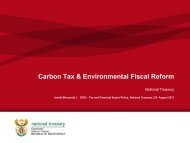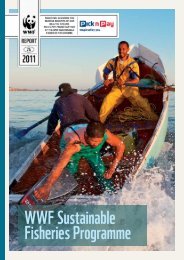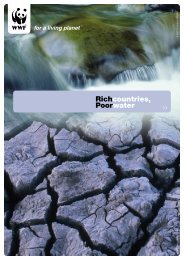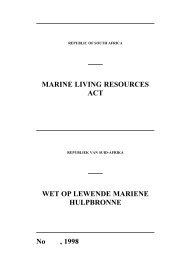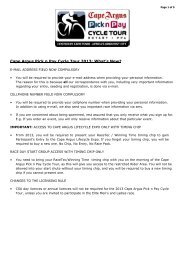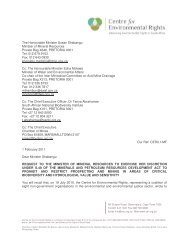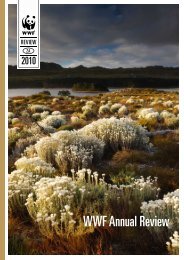State of Management of South Africaââ¬â¢s ... - WWF South Africa
State of Management of South Africaââ¬â¢s ... - WWF South Africa
State of Management of South Africaââ¬â¢s ... - WWF South Africa
- No tags were found...
Create successful ePaper yourself
Turn your PDF publications into a flip-book with our unique Google optimized e-Paper software.
STATE OF MANAGEMENT OF SOUTH AFRICA’S MARINE PROTECTED AREASnetwork <strong>of</strong> MPAs by 2012. This target was reflected in the CBD’s work programme on marineand coastal biodiversity.1.1.2 Definition and purpose <strong>of</strong> MPAsIn order to get an accurate measure on the achievement <strong>of</strong> international obligations andprogrammes, it is essential to establish a common understanding for what is meant by theterm MPA and what primary purpose MPAs serve.The most widely accepted definition for MPAs, given by the IUCN, is:‘any area <strong>of</strong> inter-tidal or sub-tidal terrain, together with its overlying water andassociated flora, fauna, historical, or cultural features, which has been reserved bylaw or other effective means to protect part or all <strong>of</strong> the enclosed environment’.(IUCN, Resolution 17.38).There are key elements in this definition that several authors have incorporated in their ownanalogous definitions for MPAs. These elements are: MPAs are designated marine areas that can include subtidal and intertidal areasMPAs have some form <strong>of</strong> protection and most <strong>of</strong>ten this is legally established, but itcan be established through customs and traditionsMPAs are important not only for the protection <strong>of</strong> natural features but also culturalfeatures and traditional uses or cultural practicesThe protection provided by a MPA should cover the seabed and the water columnAn MPA does not necessarily have the same level <strong>of</strong> protection throughoutThe IUCN redefined the term protected area in 2007 as:‘A clearly defined geographical space, recognised, dedicated and managed, throughlegal or other effective means, to achieve the long-term conservation <strong>of</strong> nature withassociated ecosystem services and cultural values’.This definition supersedes the 1999 definition <strong>of</strong> MPA and consequently a marine area needsto fall within the IUCN definition for the protected area to be considered as a MPA (UNEP-WCMC 2008). This new definition clearly depicts that protected areas must be conservationfocusedand precludes sites with the primary purpose <strong>of</strong> resource extraction. However itdoes not prohibit additional purposes for protected areas such as research, education,fisheries management and the improvement <strong>of</strong> livelihoods providing that they are consistentwith conservation (IUCN-WCMC 2008).The term MPA has been applied widely to marine sites that meet the IUCN definition forprotected areas regardless <strong>of</strong> differences in the additional purposes, design, managementapproach and the gazetted name (IUCN-WCMC 2008). Some authors have broadened thedefinition <strong>of</strong> MPAs so to emphasise that variation in purpose, design and managementapproach, is a characteristic <strong>of</strong> the term ‘MPA’. Martin et al (2006) described the MPA as ‘aPg 3




